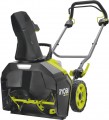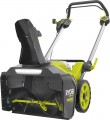Working width
The width of the strip of snow that the snow blower can clear in one pass. The larger the capture width, the fewer passes will be required to process the site, which is especially important on large areas. On the other hand, for processing small spaces, clearing individual paths, etc. significant width is not required (moreover, a “narrow” snow blower will pass more easily in a hard-to-reach place). The larger the capture width, the more powerful the engine, usually, ceteris paribus.
The most compact modern snow blowers have a working width of
less than 50 cm, these are mainly electric models of low power, although gasoline units are also found. A width of
50 – 60 cm can be called relatively small,
60 – 70 cm — medium, and in the largest models this figure
exceeds 70 cm.
Snow height
The maximum thickness of the snow layer that the snow blower removes in one pass. If you plan to regularly remove snow as it falls in a small area (for example, in the courtyard of your own private house), a grip height of up to 20 cm will be enough. If the opportunity to remove snow is rare (for example, in a country house where you visit only on weekends), you should pay attention to more powerful models with a height of about 50 cm.
Max. throw distance
The maximum distance to which the snow blower can throw the collected snow (for models without throwing distance adjustment, the operating range itself). This value is rather arbitrary, since snow can be strongly dispersed in flight. Nevertheless, it characterizes the capabilities of the unit well and allows you to compare it with other models.
Long range is important mainly when working on large areas — it allows you to throw snow across the cultivated area so that it does not have to be collected a second time. As for specific figures, the value
up to 10 m is considered relatively small,
11 – 15 m — average, and in the most "long-range" models this figure can be
16 m or more.
Auger / brush diameter
The diameter of the working tool of the snow blower. Other things being equal (primarily engine power), a smaller diameter auger gives more force during rotation, and a larger diameter auger allows you to process more snow in the same time. Therefore, units with large augers can be recommended primarily for working with large volumes of relatively soft snow, and with small ones — for dense packed cover and crust.
Capacity
The capacity of the battery used in the electrical unit with the appropriate power supply (see "Engine type").
Theoretically, a higher capacity allows you to work longer on a single charge, but in fact, not everything is so simple. Firstly, battery life will also depend on the characteristics of the unit itself, primarily on the working (and, accordingly, consumed) engine power. Secondly, the actual amount of energy stored by the battery is determined not only by the number of amp-hours, but also by the operating voltage in volts. In other words, two batteries with the same Ah but different operating voltages will have different actual capacities. In fact, all this means that only snow blowers with similar engine power and the same battery voltage can be compared in terms of capacity, and then very approximately. It is best to evaluate battery life according to the operating time directly stated in the characteristics.
Battery type
The model of a standard battery allows you to find out its characteristics in more detail, and also helps you understand what devices it is like and which one should be purchased in case of a replacement due to a malfunction or, if necessary, buy another similar one.
Charging time
The time required to fully (from 0 to 100%) charge the battery in the snow blower (see "Engine type"). Typically, a larger battery will take longer to charge, but manufacturers can use different technologies to speed up the process — this affects the cost, but saves time.
Wheels diameter
Snow blower wheel diameter. Permeability primarily depends on this parameter: the larger the diameter of the wheels, the easier they will overcome obstacles in the form of curbs, stones, bumps, etc. This is especially important for self-propelled models (see "Design"); on the other hand, larger wheels require a more powerful engine. Therefore, if the unit is to be used on more or less flat terrain, it makes sense to choose a model with smaller wheels.
The smallest diameter found in modern snow blowers is about 12 – 13 cm; in the largest and heaviest models, it can reach 50 cm.
Noise level
The average noise level produced by the snow blower during operation; the actual volume may differ slightly from this figure, but these deviations are usually negligible.
Note that snow blowers are quite loud equipment, plus the higher the power, the generally higher the noise level. This parameter is measured in decibels, this is a non-linear value, so the actual loudness is easiest to evaluate using comparative tables. So, the most "quiet" modern models give out about 55 – 60 dB — this can be compared with a conversation in slightly raised tones. 70 dB corresponds to a loud conversation, 80 dB to noise on a busy city street, 90 dB to a freight car at a distance of about 7 m, 100 dB to an industrial workshop, 110 dB to a tractor motor at a distance of 1 m.
The lower the noise level, the more comfortable this model will be to use. And according to sanitary standards, the maximum noise level considered safe for prolonged exposure (up to 8 hours) is 80 dB. So if the selected unit is noisier, and you plan to work often and for a long time, you should take care of protective headphones or earplugs.

